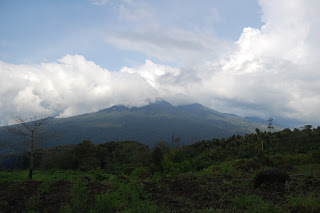 This wonderfully versatile spice is derived from the inner bark of the cinnamon trees. They are often used as condiments in cooking and baking as well as in flavoring drinks and desserts. I have always wondered what they looked like. These trees are beautiful, tall trees with nice long trunks that measure no more than 12 inches in diameter at its thickest point, with the leaves at the tops of the trees. These trees grow well in this high organic soil with its forest-like environment. From my chats with the locals, it takes at least 8 years before the tree is deemed to be ready to be harvested.
This wonderfully versatile spice is derived from the inner bark of the cinnamon trees. They are often used as condiments in cooking and baking as well as in flavoring drinks and desserts. I have always wondered what they looked like. These trees are beautiful, tall trees with nice long trunks that measure no more than 12 inches in diameter at its thickest point, with the leaves at the tops of the trees. These trees grow well in this high organic soil with its forest-like environment. From my chats with the locals, it takes at least 8 years before the tree is deemed to be ready to be harvested. In these cinnamon "farms", when the tree is mature, it is chopped down and processed. The trunks are cleared of the branches and chopped into these spindly-looking logs. The trunk is stripped of its outer bark and a beautiful brown trunk remains.
In these cinnamon "farms", when the tree is mature, it is chopped down and processed. The trunks are cleared of the branches and chopped into these spindly-looking logs. The trunk is stripped of its outer bark and a beautiful brown trunk remains.  These bark-less trunks are then further sized down into strips approximately 1m long before being bundled and sent to drying areas.
These bark-less trunks are then further sized down into strips approximately 1m long before being bundled and sent to drying areas.In the Kerinci area, these pure cinnamon "sticks" are further sized down into strips of about 12 inches and set out to dry in the sun where it will curl when dry, taking about 4-6 hours. When thoroughly dried, the color turns into a rich brown and the strips are then sold to warehouses who then shipped them off to large spice producers, where they are further processed to either cinnamon sticks or cinnamon powder and packaged accordingly. Proper drying of these strips are essential to prevent fungus growth which would require treatment and reducing the quality of the cinnamon.
Studies have also been conducted on this spice and there are several studies that suggest that cinnamon may have a regulatory effect on blood sugar, making it especially beneficial for people with Type 2 diabetes. Cinnamon also has an anti-clotting effect on the blood and has been used in studies on the treatment of athritis. One study found that smelling cinnamon boosts cognitive function and memory. When added to food, it inhibits bacterial growth and food spoilage, making it a natural food preservative. It is also a great source of manganese, fiber, iron, and calcium.
So, if you have ever wondered what is the source of the cinnamon spice, it is actually the inner bark of a tree. This is one tree that I would like to add to the farm and hope to be able to get the seedlings in the near future.

Hi SHL, I love what you are doing and I am rooting for you. I am so glad to stumble upon your blog. Hopefully, I can come and visit you at your farm(?).
ReplyDeleteWishing you continuous success!
Thank you for your comments. I always look forward to visitors. If you plan to be in the area, do send us an e-mail beforehand.
ReplyDelete